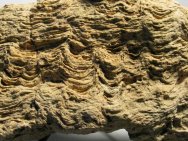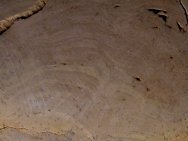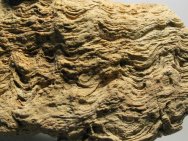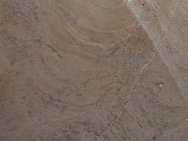| 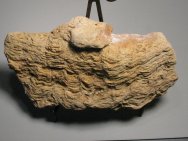 Description:
Somehow this Paleozoic stromatolite from the Oneota Formation
in Wisconsin escaped the metamorphic processes of the earth,
and essentially retained its "living" form. It is
some 495 million years old, from a time that Prokaryotic life
forms no longer had exclusive use of earth's shorelines. By
this time in geological history, microbial communities consisted
of complex consortia of both prokaryotic and eukaryotic forms
with diverse metabolic needs, and competition for Description:
Somehow this Paleozoic stromatolite from the Oneota Formation
in Wisconsin escaped the metamorphic processes of the earth,
and essentially retained its "living" form. It is
some 495 million years old, from a time that Prokaryotic life
forms no longer had exclusive use of earth's shorelines. By
this time in geological history, microbial communities consisted
of complex consortia of both prokaryotic and eukaryotic forms
with diverse metabolic needs, and competition for 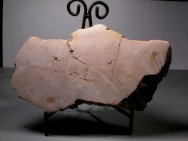 resources
and differing motility among them made for an intriguing microcosm
of interacting life, some autotrophic, some chemotrophic and
some heterotrophic. resources
and differing motility among them made for an intriguing microcosm
of interacting life, some autotrophic, some chemotrophic and
some heterotrophic.
Remaining
in its ostensibly natural form, this stromatolite would be
great either for display or as a teaching tool. This
large specimen comes from the domal top of a microbial colony. It
has been cut vertically so that the inner stratified layers
can be on
one side, and the natural external surface on the other.Apparently,
it comes from a tidal environment that eroded the stromatolitic
colony, so that it took on toadstool-like appearance like the
modern day stromatolites in Shark Bay Australia.
By
this time in geological history that these stromatolites were
formed, microbial communities consisted of complex consortia
of both prokaryotic and eukaryotic forms with diverse metabolic
needs,
and competition for resources and differing motility among them
made for an intriguing microcosm of interacting life, some
autotrophic,
some chemotrophic and some heterotrophic. However, stromatolite
reefs are believed to have regained a temporary foothold following
the extinctions even that concluded the Cambrian Period. Since
these stromatolites are at the very base of the Ordovician,
they
may well have been part of the resurgence when predation by other
organisms was temporarily, at least, suppressed.
|


